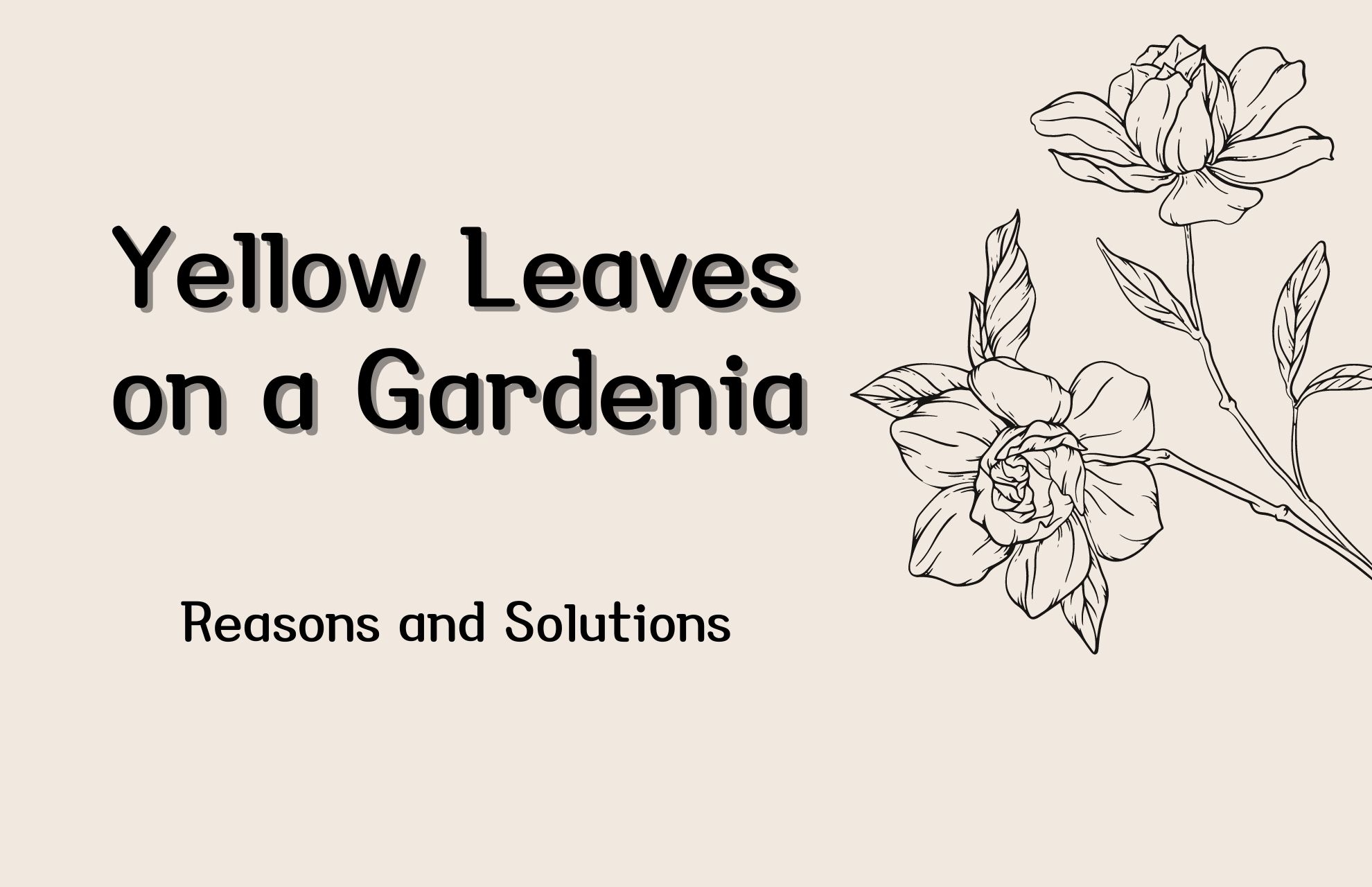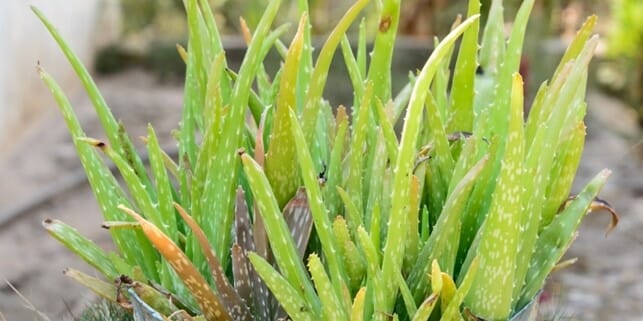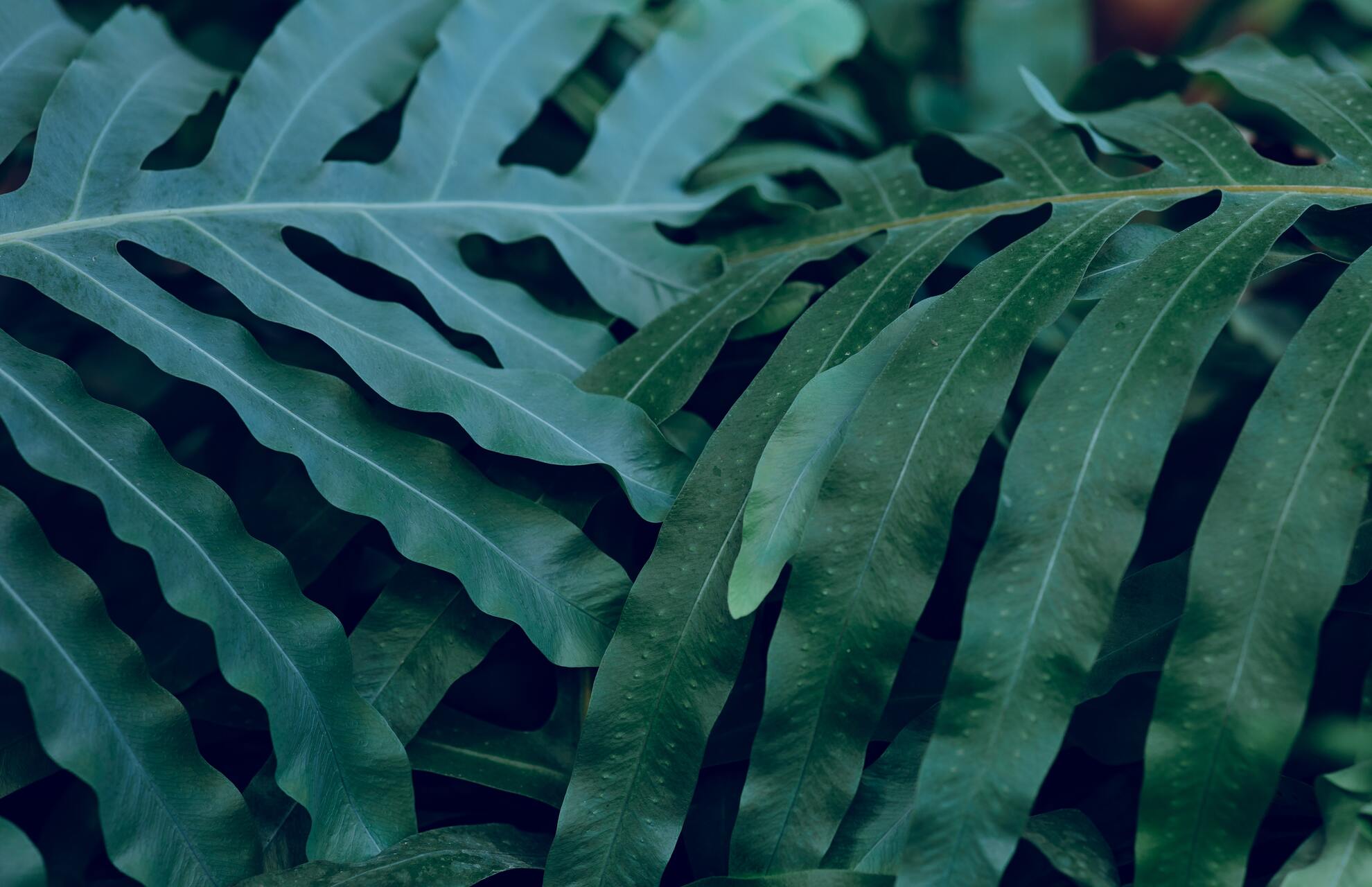A gardenia’s yellow leaves could indicate a number of different issues. Here are the signs to look for in your gardenia to determine what is wrong.
The appearance of your shrub can be ruined by gardenia leaves turning yellow, and it’s understandable to be afraid of losing your shrub. But don’t worry—there aren’t many issues that yellow leaves can signal that are seriously harmful to your health.
But why do your gardenia’s leaves turn yellow, and how can you fix the issue? Gardenia leaf yellowing could indicate a variety of issues, including poor soil pH, too much moisture in the soil, and drought stress.
Due to temperature drops in the winter and early spring, many of the issues that can affect gardenias start to manifest. The main reasons why gardenia leaves turn yellow are discussed here, along with solutions for your garden.
Read:
Natural Aging
You shouldn’t be concerned about the one natural exception to the rule that prevents gardenia leaves from turning yellow. Simply yellowing and dropping, old gardenia leaves. Although it can happen at any time of year, it usually occurs more frequently in the fall and winter.
The answer is straightforward: you don’t need to do anything if you notice that your gardenia’s occasional leaf is turning yellow and it is not a new one. You can cut it for aesthetic reasons, but you should let it grow naturally.
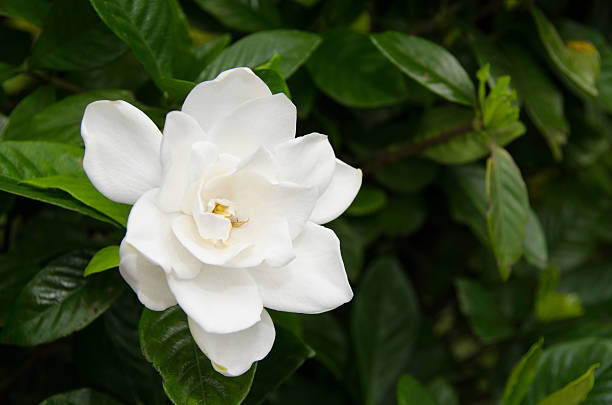
Overwatering Or Underwatering
Never make the mistake of overwatering or underwatering gardenias. The leaves may turn yellow in either scenario. Don’t misunderstand me; the occasional overwatering or brief delay won’t cause any issues. But if this continues for a long time, your shrub’s foliage will suffer.
Gardenia leaves will become yellow, then dark, mustard yellow, and finally even brown as a result of overwatering.
As the leaf ages, more and more of the leaf will become brown, beginning at the tips. In fact, your plant might even have root rot as a result of this severe situation.
- Put an immediate stop to watering and amend the soil with sand. Wait for some time and if the problem does not improve, look at the next section on root rot. This is a delicate subject.
- Restart watering after a couple or three weeks, and reduce the amount of water you give each time. The soil needs to get somewhat dry but not completely dry, so don’t wait too long. Your goal is to let water pockets drain, not to completely dry out the soil grains.
- Get rid of the decaying leaves! They could spread the rot and draw pests. Additionally, you will get rid of some of the extra water your plant was using.
In case it is underwatering, the leaves will turn yellow but dry, and they will brown in patches, not as a constant progression from the tip of the leaf. Additionally, it will be dry and have a light color. What can you do?
- Water your plant immediately, but do not give excessive water, just use the correct quantity of 1 inch.
- Water again a week later; don’t be tempted to give extra watering unless it’s very hot indeed. If the top inch or two of the soil is dry, continue.
- Make sure you adhere to the proper schedule. To ensure that you don’t forget, you can put a reminder in your calendar. But don’t forget to calculate rainy days…
- You can remove dry leaves. They will eventually drop, so there is no need for this. Please proceed even if the plant does not appear healthy.
Due to Root Rot
Root rot is a very, very serious issue. You might even lose your plant, which is a very serious and likely outcome and is not an uncommon occurrence.

You must take immediate action if the plant doesn’t recover in two to three weeks, or worse yet if the rotted yellowing persists and spreads to the branches.
- Pick a day that is dry and sunny. Don’t go outside on humid days, even in the winter. You’ll learn why it’s better if you start early in this article.
- Uproot the plant. Yes, we are in this very advanced stage. When doing this, you must take care to avoid damaging the main roots. Grab a fork, loosen the soil, and then use a shovel to dig deeply all the way around the plant. Be sure to go deeper than the drop line, which is the line connecting the first leaf and the soil. Remove the shrub in its entirety slowly.
- Place the shrub on a plastic sheet with its side up. Turn the plant carefully and slowly.
- Take most of the soil out. Don’t remove all; you need to leave some, but make sure you can see the roots clearly.
- Check for root rot. Look for signs of rotting roots, such as soft roots turning yellow, brown, or even black, lacerations in the roots, and roots that are unusually swollen (from being overwatered).
- Use a sterile blade to cut all the decaying roots. Make sure to make generous cuts; cut more often than not. Furthermore, clean the blade with vinegar or alcohol! Any germs on it will end up straight into your ailing gardenia…
- On the broken roots, apply apple cider vinegar. This acts as a disinfectant and will prevent pathogens from entering the roots. The growth of new roots will also be encouraged.
- A few hours should pass while the plant’s roots dry out. This can continue for a few days with other plants. not when handling delicate gardenias. Ideal time frames are from morning to evening.
- Totally empty the hole where the gardenia was. Remove all of the soil because it contains the pathogens that cause root rot.
- The sides and bottom of the hole should be covered with organic carbonated charcoal. The pathogens responsible for root rot will be eliminated by this. All you need is a very thin layer. You want healthy soil, not a sterile one, so keep your excesses to a minimum.
- Apply fresh soil when replanting the gardenia. Make sure it is loose and filled with drainage material. At this point, your plant will also require aeration because the roots need to breathe.
- To stabilize it, lightly compact the soil with your feet after watering the plant. At this point, watering is necessary, but don’t overdo it.
The plant will endure if it is still robust enough. However, root causes can be fatal, and in fact, the worst-case scenario was just witnessed.
Does Not Have Proper Drainage
Poor drainage will have effects that are similar to overwatering. Check to see if there is enough sand, gravel, etc. in the soil.
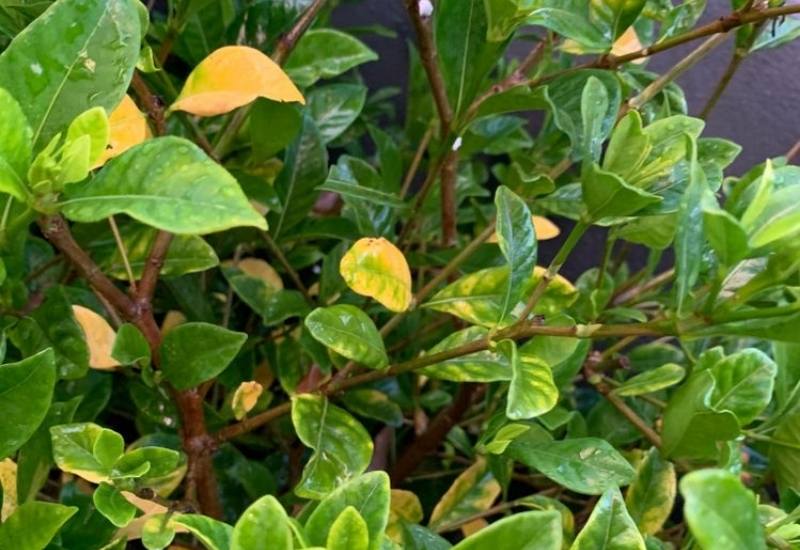
- Reduce watering temporarily and space it out over more sessions. Reduce the total amount of watering by about a third and apply it twice a week for the same amount. Water will flow through the soil more effectively as a result.
- Fill the soil with a lot of drainage material. Sand, gravel, perlite, etc. are all good options. It’s best to use a mix, but don’t dig it in; you’ll only deplete the soil and run the risk of damaging your gardenia’s roots. You won’t be able to reach the deep roots this way.
- Within a month, resume regular watering. Don’t forget that you will need to adjust your watering if it is particularly hot or wet outside.
Excessive Light
For your gardenia’s foliage, both indoors and out, even too much light can be a problem. The leaves may dry out and turn yellow; in this case, scorching is frequently present as well.
Keep in mind that gardenias prefer shade during the hottest times of the day even though they enjoy fresh sunlight. So, in case the plant is in your garden, and you can’t move it…
- From noon until dusk, provide shade for your shrub. It’s simple to do with a shading net or an alternative, especially in the summer. Even an old sheet from a previous use will work.
- Move your gardenia; make sure it stays at least 8 feet (2.4 meters) from a window, and choose a window that at least does not face south.
Too Little Light
The leaves gradually lose color until they turn yellow when there is little light. Compared to too much sunlight, this phenomenon is much slower but more consistent.
The dark sheen they have when they are healthy will initially disappear, turning them a pale green color.
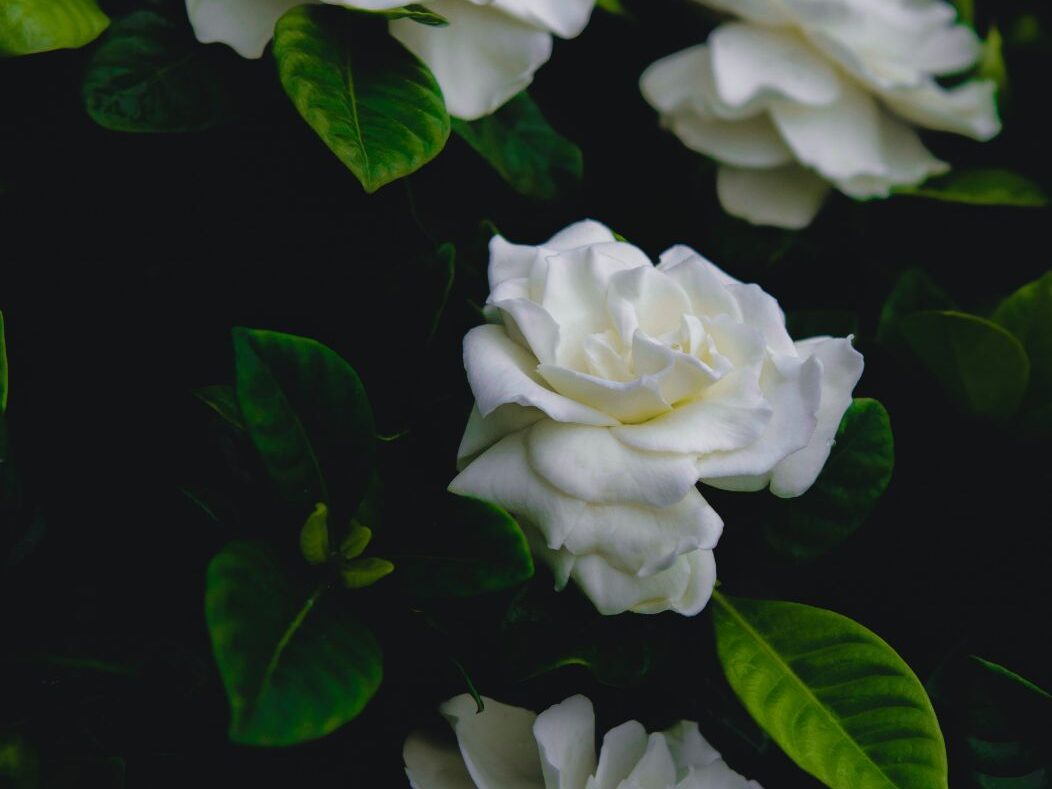
The leaf might then be permanently lost at this point as the green turns to yellow. Additionally, it will frequently affect all of the leaves at once, the majority of them, or all of the leaves on one side of the shrub.
- Simply move the pot to a brighter place; your plant will recover pretty fast and safely.
- If the shade is due to moveable structures, like a wood panel, or an internal wall, you may consider the option of moving the structure that stops the light.
- Alternatively, your only option is to move the whole plant to a brighter place. Unless the problem is really severe, wait till fall to do this; that’s the best time for changing their home, and they don’t take too well to transplant, especially when they are mature, so be very delicate and considerate.
Your Gardenia Got Too Cold
Gardenias fare better at very moderate temperatures: during the day, 65 to 70oF (18 to 21oC) while at night, 60 to 65oF (15 to 18o C).
Leaf yellowing and eventual drop may result from any extended periods spent under these. If the weather is colder than anticipated, what can you do?
- Mulch! Warm roots could work the magic because mulching raises soil temperature.
- From chilly winds, protect your shrub. Sometimes all your gardenia needs to stay healthy is to stay out of the cooler winds, especially those coming from the north.
- Cover your gardenia. You must wrap it up warmly in colder climates. A plastic sheet with ventilation will work perfectly, particularly if you place some straws at the base of the plant. This will generate heat and give your delicate shrub a mini-greenhouse.
Nutrient Deficiency
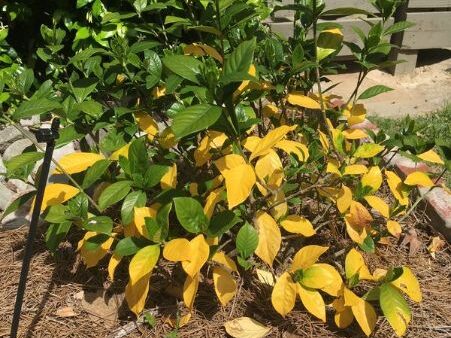
Possible accompanying yellow patches would be bent leaves, some brown dots, etc. are a matter of nutrient deficiency in many cases. Poor feeding and high soil pH are two potential causes; we’ll examine the first now and the second later.
Poor feeding typically occurs when a plant is in a pot or when incorrect fertilizers, even organic ones, are used.
This is due to the fact that they nourish the plant but not the soil. On the other hand, organic matter like compost will feed the soil, and this usually provides your gardenia with everything it needs to grow.
- A common nutrient deficiency in gardenias is iron. Young leaves in this situation often develop a burnt brown tip and turn yellow.
- Manganese deficiency results in patched yellow leaves with dead areas.
- Sulfur and/or calcium deficiency will produce dwarf yellow leaves.
- Potassium deficiency will see your leaves yellowing at the margins and then progressing toward the middle.
- Phosphorus deficiency gives you a dull shade of yellow in the leaves that grow slowly, old leaves turn dark green and they slowly die.
- Nitrogen deficiency gives you yellowing that starts from the margins in young leaves, and from the midrib in older leaves. The plant’s base is typically where the crippled and wiry leaves first appear.
You can see that the symptoms are very specific, but hold off on giving them the precise minerals just yet. There are far more straightforward and straightforward methods!
As a general rule, try to have healthy and living soil, using leaves, compost, and worms, and avoiding chemicals at all costs.
Check to see if it is not compacted and if there are healthy organisms present. The soil will provide your plant with the correct nutrients in these circumstances.
However, occasionally we are unable to do this because of nearby street or garden pollution.
- Change to a fertilizer specifically designed for gardenias (and camellias). But be careful not to over-fertilize. Problems can arise even from an excess of nutrients. It will take some time, but once your plant begins to metabolize the proper nutrients, it will start to grow once more. However, it might take more than a month.
- If possible, switch to composting.
- Verify the soil’s pH! You can solve all of your problems by fixing it because it is too high.
High Soil PH
Gardenia thrives in soil with a pH between 5.0 and 6.0 as an acid-loving plant. but when the pH goes past 6.5, gardenia leaves will become yellow (chlorotic) due to iron deficiency caused by alkaline soils.
Plants become malnourished when the pH is off. They consume an excessive amount of some nutrients and insufficient amounts of others.
This has nothing to do with the concentration of each nutrient in the soil. So, if acidity is the issue, even with the proper balance of fertilizer, you won’t see any results.
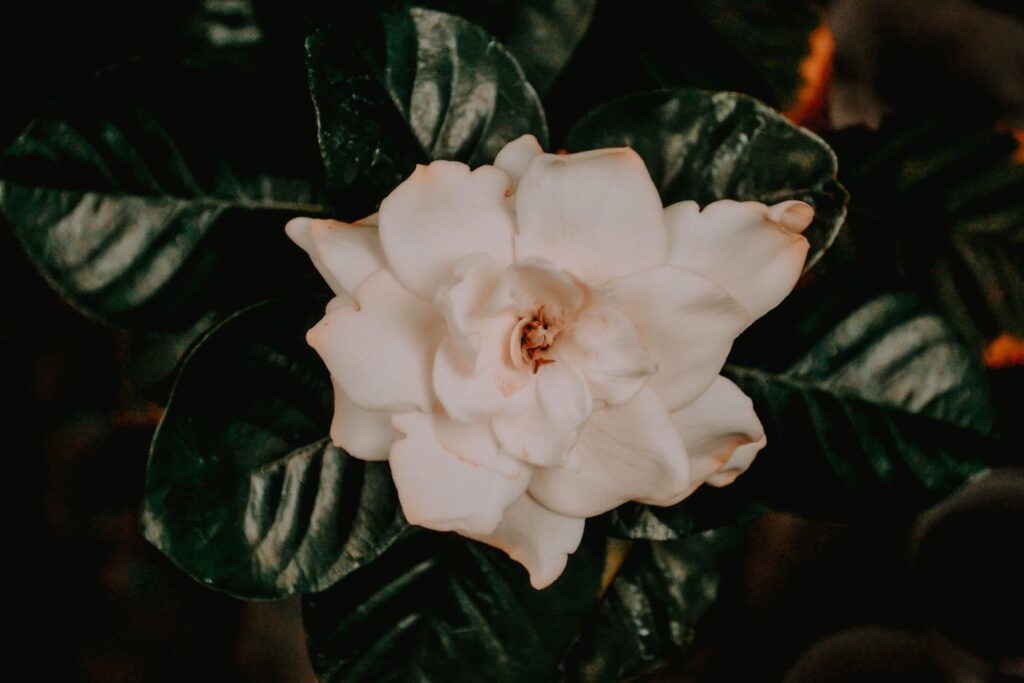
The amount of each nutrient that a plant’s roots can absorb depends on how low or high the pH is. So, if the pH is too high, you need to correct the soil’s acidity. Do this also as prevention,
especially if your soil is naturally in the neutral or alkaline range; even if you use acidic soil for your acidophilic plants, it will automatically tend to revert back to the original pH.
But how?
- Do not use chemicals. They kill the numerous tiny organisms that are your gardenia’s best friends because they are too aggressive and harsh.
- The pH of the soil is lowered by freshly ground coffee. They don’t work well with most plants, but they are ideal for gardenias!
- Your gardenias deserve some tea. Yes, they like a “cuppa”! whether you give them a real cup, cold tea or tea leaves it’s fine, as long as it is black tea, which has acidic pH. Don’t be fooled; green tea is very alkaline.
- Orange and lemon peels added to the soil regularly can help keep the pH low. But don’t put them in the compost. You should save them for your gardenia’s feet.
Maintenance and Care of Gardenia
If you use saucers under your pots, always tip any water out of them because gardenias love even the slightest amount of moisture, but their roots quickly rot in soils with poor drainage. When they are actively absorbing nutrients, in late spring through the end of summer, feed gardenias once a month. Use poultry manure sparingly; alternatively, fertilize with a fertilizer for flowers and fruit or seaweed.
Intense sunlight must also be avoided when growing gardenias. Gardenias benefit from being shaded by a sizable tree, such as a jacaranda or poinciana.
Many of the flower buds that form in warm autumn weather succumb to the colder winter temperatures and drop off because gardenias need daytime temperatures above 10–15°C to start flowering.

